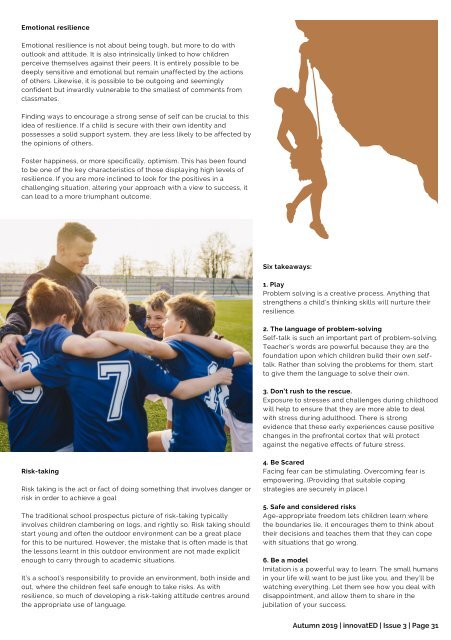innovatED Magazine - Issue 3 - Autumn 2019
A lively mix of news, articles, opinion, research, insight and regulatory updates. We take a global perspective and bring the latest developments and outstanding practice from across the world and across different sectors to enable educators to deliver the very best for their pupils. Produced by an experienced and knowledgeable teaching and school leadership team, innovatED is a termly must-read for all staff rooms.
A lively mix of news, articles, opinion, research, insight and regulatory updates. We take a global perspective and bring the latest developments and outstanding practice from across the world and across different sectors to enable educators to deliver the very best for their pupils. Produced by an experienced and knowledgeable teaching and school leadership team, innovatED is a termly must-read for all staff rooms.
You also want an ePaper? Increase the reach of your titles
YUMPU automatically turns print PDFs into web optimized ePapers that Google loves.
Emotional resilience<br />
Emotional resilience is not about being tough, but more to do with<br />
outlook and attitude. It is also intrinsically linked to how children<br />
perceive themselves against their peers. It is entirely possible to be<br />
deeply sensitive and emotional but remain unaffected by the actions<br />
of others. Likewise, it is possible to be outgoing and seemingly<br />
confident but inwardly vulnerable to the smallest of comments from<br />
classmates.<br />
Finding ways to encourage a strong sense of self can be crucial to this<br />
idea of resilience. If a child is secure with their own identity and<br />
possesses a solid support system, they are less likely to be affected by<br />
the opinions of others.<br />
Foster happiness, or more specifically, optimism. This has been found<br />
to be one of the key characteristics of those displaying high levels of<br />
resilience. If you are more inclined to look for the positives in a<br />
challenging situation, altering your approach with a view to success, it<br />
can lead to a more triumphant outcome.<br />
Six takeaways:<br />
1. Play<br />
Problem solving is a creative process. Anything that<br />
strengthens a child’s thinking skills will nurture their<br />
resilience.<br />
2. The language of problem-solving<br />
Self-talk is such an important part of problem-solving.<br />
Teacher’s words are powerful because they are the<br />
foundation upon which children build their own selftalk.<br />
Rather than solving the problems for them, start<br />
to give them the language to solve their own.<br />
3. Don’t rush to the rescue.<br />
Exposure to stresses and challenges during childhood<br />
will help to ensure that they are more able to deal<br />
with stress during adulthood. There is strong<br />
evidence that these early experiences cause positive<br />
changes in the prefrontal cortex that will protect<br />
against the negative effects of future stress.<br />
Risk-taking<br />
Risk taking is the act or fact of doing something that involves danger or<br />
risk in order to achieve a goal<br />
The traditional school prospectus picture of risk-taking typically<br />
involves children clambering on logs, and rightly so. Risk taking should<br />
start young and often the outdoor environment can be a great place<br />
for this to be nurtured. However, the mistake that is often made is that<br />
the lessons learnt in this outdoor environment are not made explicit<br />
enough to carry through to academic situations.<br />
It’s a school’s responsibility to provide an environment, both inside and<br />
out, where the children feel safe enough to take risks. As with<br />
resilience, so much of developing a risk-taking attitude centres around<br />
the appropriate use of language.<br />
4. Be Scared<br />
Facing fear can be stimulating. Overcoming fear is<br />
empowering. (Providing that suitable coping<br />
strategies are securely in place.)<br />
5. Safe and considered risks<br />
Age-appropriate freedom lets children learn where<br />
the boundaries lie, it encourages them to think about<br />
their decisions and teaches them that they can cope<br />
with situations that go wrong.<br />
6. Be a model<br />
Imitation is a powerful way to learn. The small humans<br />
in your life will want to be just like you, and they’ll be<br />
watching everything. Let them see how you deal with<br />
disappointment, and allow them to share in the<br />
jubilation of your success.<br />
<strong>Autumn</strong> <strong>2019</strong> | <strong>innovatED</strong> | <strong>Issue</strong> 3 | Page 31






